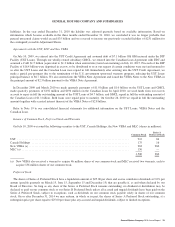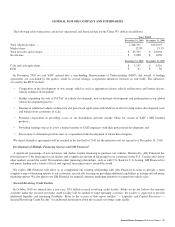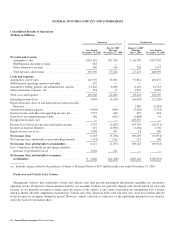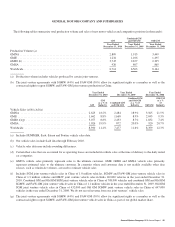General Motors 2010 Annual Report Download - page 41
Download and view the complete annual report
Please find page 41 of the 2010 General Motors annual report below. You can navigate through the pages in the report by either clicking on the pages listed below, or by using the keyword search tool below to find specific information within the annual report.GENERAL MOTORS COMPANY AND SUBSIDIARIES
These four brands accounted for 99.4% of our U.S. vehicle sales in the year ended December 31, 2010. The moderate improvement in
the U.S. economy has contributed to a slow but steady improvement in U.S. industry vehicle sales and increased consumer
confidence.
The continued increase in U.S. industry vehicle sales and the vehicle sales of our four brands is critical for us to maintain our
worldwide profitability.
U.S. Dealer Reduction
We market vehicles worldwide through a network of independent retail dealers and distributors. As part of achieving and sustaining
long-term viability and the viability of our dealer network, we determined that a reduction in the number of U.S. dealerships was
necessary. In determining which dealerships would remain in our network, we performed analyses of volumes and consumer
satisfaction indexes, among other criteria, and over 1,800 U.S. retail dealers signed wind-down agreements effectively terminating
their dealer agreements with us on October 31, 2010. Pursuant to legislation passed in December 2009 over 1,100 dealers filed for
arbitration seeking reinstatement. In 2010 the arbitration process was resolved. As a result of the arbitration process we offered 332
dealers reinstatement in their entirety and 460 existing dealers reinstatement of certain brands. At December 31, 2010 there were
4,500 vehicle dealers in the U.S. compared to 5,600 at December 31, 2009.
Section 136 Loans
Section 136 of the Energy Independence and Security Act of 2007 (EISA) established an incentive program consisting of both
grants and direct loans to support the development of advanced technology vehicles and associated components in the U.S. In January
2011 consistent with our strategy to maintain a strong balance sheet by minimizing our financial leverage, we withdrew our $14.4
billion loan application, under Section 136, to the U.S. Department of Energy.
Brand Rationalization
We have focused our resources in the U.S. on four brands. As a result, we completed the sale of Saab Automobile AB (Saab) in
February 2010 and the sale of Saab Automobile GB (Saab GB) in May 2010 and have completed the wind down of our Pontiac,
Saturn, and HUMMER brands.
Sale of Nexteer
On November 30, 2010 we completed the sale of Nexteer, a manufacturer of steering components and half-shafts, to Pacific
Century Motors. The sale of Nexteer included the global steering business which was acquired in October 2009. The 2009 acquisition
of Nexteer included 22 manufacturing facilities, six engineering facilities and 14 customer support centers located in North and South
America, Europe and Asia. We received consideration of $426 million in cash and a $39 million promissory note in exchange for
100% of our ownership interest in Nexteer and recorded a gain of $60 million on the sale.
Resolution of Delphi Matters
In October 2009 we consummated the transaction contemplated in the Delphi Master Distribution Agreement (DMDA) with Delphi
Corporation (Delphi) and other parties. Under the DMDA, we agreed to acquire Nexteer, which supplies us and other original
equipment manufacturers with steering systems and columns, and four domestic facilities that manufacture a variety of automotive
components, primarily sold to us. We, along with several third party investors who held the Delphi Tranche DIP Facility (collectively,
the Investors), agreed to acquire substantially all of Delphi’s remaining assets through New Delphi. Certain excluded assets and
liabilities had been retained by a Delphi entity (DPH) to be sold or liquidated. In connection with the DMDA, we agreed to pay or
assume Delphi obligations of $1.0 billion related to its senior DIP credit facility, including certain outstanding derivative instruments,
its junior DIP credit facility, and other Delphi obligations, including certain administrative claims. At the closing of the transactions
contemplated by the DMDA, we waived administrative claims associated with our advance agreements with Delphi, the payment
terms acceleration agreement with Delphi and the claims associated with previously transferred pension costs for hourly employees.
General Motors Company 2010 Annual Report 39
























